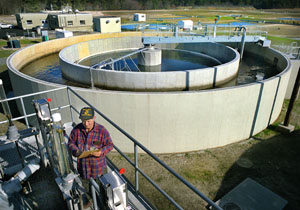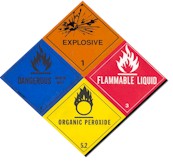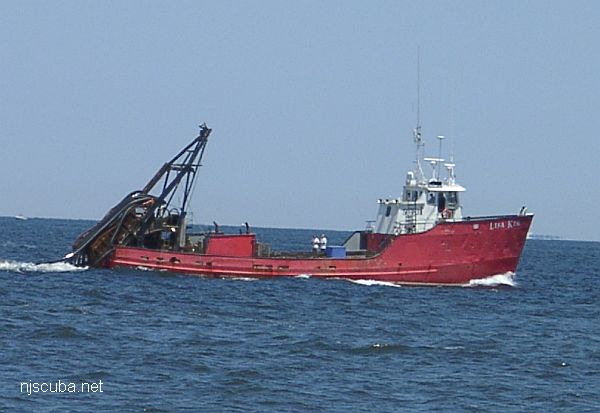Water Pollution (2/7)
Sewage
Sewerage is the system for the removal and disposal of chiefly liquid wastes and of rainwater, which are collectively called sewage. The average person in the industrialized world produces between 60 and 140 gallons of sewage per day.
Types of Sewage Disposal Systems
Domestic sewage, produced in urban residences, institutions, and businesses, is usually collected by pipes and conduits called sanitary sewers, which lead to a central discharge point. In rural residences, domestic sewage is often collected in a septic tank on the property. Industrial wastes, which consist of liquids produced in manufacturing processes, are sometimes collected in sanitary sewers, but the nature of many industrial wastes may make it dangerous or difficult to do so. Often industries dispose of their own wastes. Storm sewage, which comes from rain and groundwater, is collected either in a storm sewer or, with domestic sewage and industrial wastes, in what is called a combined sewer.
Sewer pipe must be strong enough to withstand the structural stresses to which it is subjected by being buried in the ground. In addition, the pipe itself and the joints between sections of pipe must be capable of withstanding at least moderate water pressure without significant leakage of sewage into the environment. Materials used for sewer pipe include plastics, vitrified clay, cast iron and steel, corrugated iron, concrete, and asbestos cement. Although usually circular, pipes are also made egg-shaped or semi-elliptical so that suspended solids do not accumulate even at a relatively low rate of flow, about 2 ft (.6 m) per second. Sewer pipes are usually inclined downward toward the central collection point so that sewage will flow to it naturally, although pumping stations may be required.
Sewage is eventually discharged into underground or surface watercourses that naturally drain an area. In past centuries, the dilution produced by discharging sewage into large bodies of water was considered sufficient to render harmless any toxic substances contained in it. However, the volume of sewage is now so great that dilution is no longer considered an adequate safeguard.
Sewage Treatment
The biochemical processes that take place in water bodies have also been relied on to neutralize sewage. Aerobic, or oxygen-requiring, bacteria feed on the organic material in sewage, decomposing it. However, this process uses the oxygen that is dissolved in water. Often the concentration of organic waste is so great that the biochemical oxygen demand (BOD) depletes the water's oxygen supply, killing fish and plants. In order to avoid these problems, it is now recognized that all sewage except unmixed storm sewage must be treated before it is discharged.

Sewage treatment is classified as primary, secondary, or tertiary, depending on the degree to which the effluent is purified. Primary treatment is the removal of floating and suspended solids. Secondary treatment uses biological methods such as digestion. Complete, or tertiary, treatment removes all but a negligible portion of bacterial and organic matter. Industrial wastes are treated by a number of methods, depending on the specific nature of the waste. Increasingly, governments are forcing industries to process effluents either chemically or mechanically, or both ways, so that harmful substances are removed.
Domestic sewage must be treated to produce discharge water that is free of odors, suspended solids, and objectionable bacteria. ( Coliform bacteria, which inhabit the lower intestines of mammals, while not pathogenic of themselves, are taken as an index of contamination of watercourses. ) In rural areas, sewage can be stored in a holding tank, e.g., a septic tank; naturally occurring anaerobic bacteria can decompose the solids, which then settle to the bottom. While suitable for small systems, this method has several disadvantages. First, anaerobic decomposition produces noxious gaseous effluents, and it is fairly slow. Second, harmful bacteria may still be present in the liquid effluent.
In large urban systems, a combination of processes must be used. Decomposition can be speeded by forcing air through the mass so that aerobic bacteria can be used. This oxidation process is typically combined with filtration, either in sand or in granular activated carbon, and with several hours of aeration. The liquid can then be discharged, often after being disinfected with chlorine. Another method of removing solids is to allow the liquid to stand in large tanks until the solids fall out and form a sediment, but the process is slow and requires the accumulation of large volumes of liquid.
Once solids are removed, they are treated in one of several ways. Most often they are removed in a semi-liquid mass referred to as sludge. Sludge may be transferred to tanks where it is digested by aerobic or anaerobic bacteria. Gaseous byproducts of this digestion are collected for use as fuels. After digestion, solids may be dried and enriched with plant nutrients for use as fertilizer. In other cases, with or without digestion, they may be dried and incinerated at 1200 to 1400°F. In other cases, solids are buried in landfills or dumped far at sea, although environmental objections to such dumping has led to its drastic curtailment.
Historical Sewage Systems
One of the earliest known sewers was the Cloaca Maxima in Rome, built ( circa 6th century B.C. ) to drain the site of the Forum. Although London's drainage system dates from the 13th cent., the discharge of offensive waste into it was illegal until 1815. The Parisian sewers were constructed before the 16th cent., but by 1893 fewer than 5% of the city's houses were connected to the system. As early as 1701, Boston had drains. Generally, however, systematic sewage disposal was not widely introduced until the mid-19th century.
Toxic Waste

Toxic waste is waste material, often in chemical form, that can cause death or injury to living creatures. It usually is the product of industry or commerce but comes also from residential use, agriculture, the military, medical facilities, radioactive sources, and light industry, such as dry cleaning establishments. The term is often used interchangeably with "hazardous waste, " or discarded material that can pose a long-term risk to health or the environment. Toxins can be released into air, water, or land.
In 1976 the Toxic Substances Control Act required the Environmental Protection Agency to regulate potentially hazardous industrial chemicals, including halogenated fluorocarbons, dioxin, asbestos, polychlorinated biphenyls (PCBs), and vinyl chloride. Other federal legislation pertaining to hazardous wastes includes the Atomic Energy Act (1954), the Resource Conservation and Recovery Act (1976), and the Comprehensive Environmental Response, Compensation, and Liability Act, or Superfund Act (1986).
Toxic waste treatment and control has proved to be expensive and time-consuming with more resources spent on court battles than on actual cleanup. The disposal of toxic wastes is also a topic of international concern. In 1989, some 50 countries signed a treaty aimed at regulating the international shipment of toxic wastes. In some cases, such wastes are shipped to developing countries for cheap disposal without the informed consent of their governments. The often substandard shipping, storage, and treatment methods endanger human health and the health of the environment.

